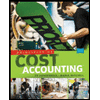
Concept explainers
(1)
Concept introduction:
Equivalent units are those units which are finished from direct materials, labour and other overhead costs at a particular percent to know the completed manufacturing during the period.
To calculate:
Number of units transferred to finished goods.
(2)
Concept introduction:
Equivalent units are those units which are finished from direct materials, labour and other overhead costs at a particular percent to know the completed manufacturing during the period.
FIFO method- is a system of stock evaluation is a cost flow statement that the first merchandise purchased are also the initial good sold. In most corporate, this assumption directly matches the actual flow of goods and so is considered the most in theory correct stock valuation method.
To calculate:
No. of equivalent units with respect to direct material (DM) and conversion for the month of May using FIFO method.
(3)
Concept introduction:
Per unit cost of production is represented by cost per equivalent production. It is determined by dividing total cost with equivalent production unit.
To calculate:
Cost per equivalent unit in respect to direct material and conversion.
(4)
Concept introduction:
Per unit cost of production is represented by cost per equivalent production. It is determined by dividing total cost with equivalent production unit.
To Allocate:
May’s cost to the units transferred to completed goods and closing work in process stock using FIFO method.
Want to see the full answer?
Check out a sample textbook solution
Chapter 3 Solutions
Managerial Accounting
- In cost accounting, stock is valued at _______ a. Market price b. Cost price c. Selling price d. Standard pricearrow_forwardPlease provide the answer to this general accounting question using the right approach.arrow_forwardDoom Ltd uses predetermined overhead rates based on labor hours. The monthly budgeted overhead is $470,000 and the budgeted labor hours were 20,000. During the month the company worked a total of 70,000 labor hours and actual overheads totaled $230,000. The overhead at the end of the month would therefore be$? General accounting questionarrow_forward
- The principle of matching costs with revenues is known as _____ principle. a. Cost b. Matching c. Consistency d. Revenuearrow_forwardDoom Ltd uses predetermined overhead rates based on labor hours. The monthly budgeted overhead is $470,000 and the budgeted labor hours were 20,000. During the month the company worked a total of 70,000 labor hours and actual overheads totaled $230,000. The overhead at the end of the month would therefore be$?arrow_forwardI am trying to find the accurate solution to this general accounting problem with appropriate explanations.arrow_forward
- The main function of cost accounting is _______ reporting a. Internal b. External c. Government d. Bankarrow_forwardDirect materials cost is Rs. 80,000. Direct labor cost is Rs. 60,000. Factory overhead is Rs. 90,000. Beginning goods in process were Rs. 15,000. The cost of goods manufactured is Rs. 245,000. What is the cost assigned to the ending goods in process?arrow_forwardHarris Company assigns overhead cost to jobs on the basis of 120% of direct labor cost. The job cost sheet for Job 205 includes $18,500 in direct materials cost and $15,200 in direct labor cost. A total of 2,300 units were produced in Job 205. Required: a. What is the total manufacturing cost assigned to Job 205? b. What is the unit product cost for Job 205?arrow_forward
- Principles of Accounting Volume 2AccountingISBN:9781947172609Author:OpenStaxPublisher:OpenStax College
 Principles of Cost AccountingAccountingISBN:9781305087408Author:Edward J. Vanderbeck, Maria R. MitchellPublisher:Cengage Learning
Principles of Cost AccountingAccountingISBN:9781305087408Author:Edward J. Vanderbeck, Maria R. MitchellPublisher:Cengage Learning Managerial AccountingAccountingISBN:9781337912020Author:Carl Warren, Ph.d. Cma William B. TaylerPublisher:South-Western College Pub
Managerial AccountingAccountingISBN:9781337912020Author:Carl Warren, Ph.d. Cma William B. TaylerPublisher:South-Western College Pub  Cornerstones of Cost Management (Cornerstones Ser...AccountingISBN:9781305970663Author:Don R. Hansen, Maryanne M. MowenPublisher:Cengage Learning
Cornerstones of Cost Management (Cornerstones Ser...AccountingISBN:9781305970663Author:Don R. Hansen, Maryanne M. MowenPublisher:Cengage Learning Financial And Managerial AccountingAccountingISBN:9781337902663Author:WARREN, Carl S.Publisher:Cengage Learning,
Financial And Managerial AccountingAccountingISBN:9781337902663Author:WARREN, Carl S.Publisher:Cengage Learning,




